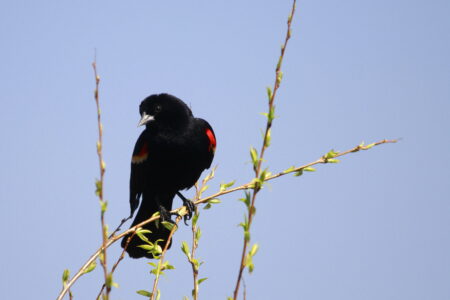Angie MacAloney-Mueller has worked on the St. Mike’s campus for more than 30 years. She currently serves as the physical plant coordinator. She has been an avid birder for more than 20 years, often venturing out with her husband Rob, who took the blackbird photo above.
To some he’s a menace, to others, he’s a marvel of nature. He is the male red-winged blackbird.

If you’ve been around Elmsley Hall during nesting season, which is in the late spring, you may have been swooped by this doting father. The male red-wings usually arrive here in March or April, after travelling hundreds–and sometimes thousands– of miles. They arrive early to find potential nesting spots and claim their territory.
The females arrive four to six weeks later, and the boys must impress and fight for a female’s attention and woo her to his territory. Once a female chooses a male’s territory, she will build the nest. She incubates the eggs for 11-12 days, and the baby birds fledge about 10 days after hatching. The male will feed the female during incubation and also assist in feeding and raising the young. Male red-winged blackbirds are fiercely protective of their nest and young, swooping at anything that gets too close, no matter the size.
As a longtime birder I have a lot of respect for the red-winged blackbird. For me they are the real sign of the arrival of spring. American robins are here year-round now, often flocking up together to survive the colder months. I once saw a red-winged blackbird swoop at an eagle on the Toronto Islands. The eagle there, or we humans on campus here, have no interest in disturbing his nest, it’s actually illegal to disturb a migratory bird nest, but he’ll do what is instinctive for him to do: protect. The males spend many hours a day watching guard over their nest site. I’ve often seen him keeping watch from the roof of Elmsley Hall or Charbonnel Lounge.
I know it can be startling to be swooped. My advice is to not react; just keep walking, don’t run or scream. If you can, make eye contact with him. He may be protective, but he’s a bit of a coward, too. I do believe we can co-exist for a couple of months while they raise their young before migrating south before the summer ends.
The question I’ve been asked most about the campus red-wing is, “Is it the same bird?” I don’t know, but it could be. The oldest one on record was over 15 years old. He was found hurt but was able to be released after recovering. If it’s not the same bird, it’s most likely one who was hatched here.
The unusual thing about these birds returning here year after year is that our grounds are not their preferred habitat. They usually prefer marshy areas and wetlands, nesting in the cattails. I guess they discovered our campus is an oasis in the city as well.
Read other InsightOut posts.
